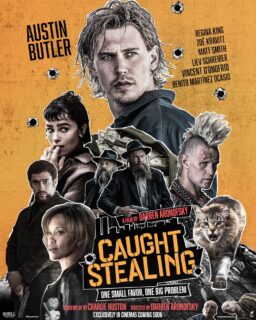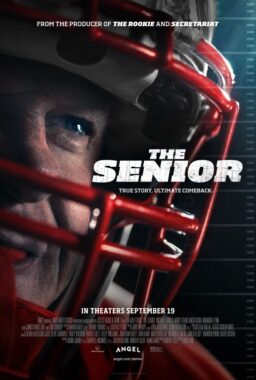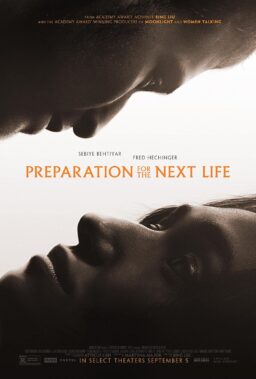Ebert’s Best Film Lists1967 – present
1. “Dark City“
The best film of 1998 was also one of the more obscure. It opened without a compelling campaign, and was yanked before it could find an audience. Now, on video, it’s beginning to build a reputation that may eventually link it with “Blade Runner,” another slow starter that gained cult status.
The movie is set in a noir city run by the Strangers, aliens who use it as a laboratory to study humans. They erase human memories every midnight and shape-shift the city into new configurations for fresh experiments. The hero (Rufus Sewell) is aided by a mysterious doctor (Kiefer Sutherland) to break lose from the mind-wiping, and remembers vaguely an earlier life that may have involved a beautiful young woman (Jennifer Connolly). Meanwhile, a police inspector (William Hurt) tries to make sense of a crime. The closing shots reveal the true nature of all that has gone before.
I responded so strongly to the film because it was intelligent, intriguing, darkly atmospheric, and most of all because it was visually breathtaking. Werner Herzog tells us we need new images or we will die. Alex Proyas’ “Dark City” was visionary in the tradition of “Metropolis,” “The Cabinet of Dr. Caligari,” “2001” and “Blade Runner.” It was a daring act of the imagination. So strongly did I feel about it that for the first time I agreed to do a commentary sound track for the DVD video, where you can hear me talking for two hours about the film’s mysteries and beauties. (I don’t get royalties.) Like “Babe: Pig in the City,’ “Pleasantville,” “The Truman Show” and “What Dreams May Come,” “Dark City” started from scratch to reimagine a world.
2. “Pleasantville“
Gary Ross’s film pointed the way to the new freedom which computer-generated images have given filmmakers. He imagined two modern-day young people who are magically transported back in time to the insides of a black and white 1950s sitcom. Nothing ever changes in the sitcom world, but they bring the seeds of the future, and soon color is blooming in the b&w society.
One of the pleasures of the film was figuring out what triggered the color shifts. (It was not simply sex, but insight, or change.) Another was to enjoy the wit with which paradoxes were handled in a world closed to space and time. (In geography class, students learned that when you got to the end of Main Street, it just started all over again.)
The film stirred debate. Some argued that the stable and predictable 1950s were, in fact, preferable to the social upheaval in which we now reside. Others said the 1950s were, in fact, more revolutionary than today–that reverse time travel could do us some good. Still others said the 1950s were great if you didn’t happen to be female or non-white. Whatever you said, the movie got you talking. Not many great entertainments also inspire social introspection.
3. “Saving Private Ryan“
Steven Spielberg’s epic was one of the most involving war movies ever made. Using enormous resources of men and technique, he re-created the landing at Omaha Beach with such power and immediacy that movie battle scenes would never seem quite the same again. His film’s opening act is one of the great sustained acts of filmmaking.
Then the film fell into more conventional but still thought-provoking channels, as an officer (Tom Hanks) and his men are assigned to venture into dangerous territory to find a private whose brothers have been killed in combat. Saving him is thought to be useful propaganda–but the war looks different at ground level than from the Pentagon.
“Saving Private Ryan” was a powerful experience. Spielberg knows how to make audiences weep better than any director since Chaplin in “City Lights.” But weeping is an immediate response, and this film also embodies ideas. After the immediate experience begins to fade, the implications remain, and grow.
4. “A Simple Plan“
Three men in a wintertime forest preserve find a crashed plane that has $4 million on board. They figure it’s probably drug money, that no one will come forward to claim it, and that it might be a simple matter for them to keep the money themselves. Almost immediately this decision involves them in a crime, and their values, held for a lifetime but never really tested, begin to disintegrate.
Sam Raimi’s film runs sure and deep. It has an uncanny sense of time and place, and it never rushes as it follows its characters from one fateful decision to the next. Strong, Oscar-worthy performances by Bill Paxton as the college graduate, Billy Bob Thornton as his unlucky brother, Brent Briscoe as the third man, and Bridget Fonda as Paxton’s wife, who gives what seems at the time like practical advice.
5. “Happiness“
Todd Solodz’s painful and funny film showed desperate people reaching out from the loneliness they were drowning in. Some were obviously pathetic, in apartment buildings that are warehouses of strangers. Others, like a Little League dad who was a psychiatrist, seemed more normal, but was trapped in a role far removed from the depraved center of his libido.
Solondz made it difficult for audiences to take a stand on these people: Tragedy kept shifting into farce or satire, and then back again. When the film premiered at Cannes, some wondered if it would ever find an audience. It did surprisingly well at the box office, perhaps because audiences realized that Solondz wasn’t simply manipulating situations for shock value, but was rotating them like specimens under a microscope, to see how they looked from various angles.
6. “Elizabeth“
The story was intriguing, but the visuals multiplied its depth and fascination. Cate Blanchett starred as Elizabeth I, her life in danger as she takes the throne as a young and untested ruler, and then grows in office into perhaps the greatest of British monarchs. Around her, advisors steer her away from (or toward) trouble; kings want her hand for political reasons, but her first true love is a disappointment, and eventually she “becomes” a virgin.
Shekhar Kapur, an Indian director, used the palate of his subcontinent to portray Elizabeth, her court and her architecture in the colors and texture of medieval India. The film is largely set in vast, echoing halls, their pillars reaching up into the shadows. He is attentive to the rustle of dresses and the clank of armor, gives us a barge on the Thames like a houseboat on a lake in Kashmir. Action is glimpsed through iron filigree screens, dresses are rich with embroidery, hair styles are ornately elaborated, and yet there is the feeling that just out of sight of these riches are the rats in the kitchen and the slop-pots in the halls.
Set aside for the moment the question of whether this film is “too dark” for children (set aside too the fact that many children see slasher and horror movies on video). Consider this “Babe” sequel as a film for adults. It is an unending parade of wonderments and visual delights, linked to a story that is Dickensian in its richness of character and the boldness of its villains.
Babe, the clever pig, is marooned in the city with Mrs. Hoggett, and finds refuge in a boarding house that is friendly to animals. There he meets an astonishing array of new friends (some dubious), and gets involved in startling adventures. Yes, some were bothered by the plight of the bull terrier who almost drowned–but isn’t it interesting that the dog’s dilemma upset more folks than the loss of a billion lives in “Armageddon?” Maybe it actually touched people. Maybe they cared. The movie’s visual imagination and art direction were astonishing.
8. “Shakespeare in Love“
A rowdy, irreverent movie with as many different tones as a Shakespeare play: High and low comedy, coincidences, masquerades, jokes about itself, topical references, exits and entrances with screwball timing. It begins as a backstage comedy, filled with lore about the Elizabethan stage and its ambitious young scribbler, Shakespeare (Joseph Fiennes), and then widens into a love story as young Will falls in love with the beautiful Viola (Gwyneth Paltrow) whose rich father is buying her a nobleman with title attached.
Much gender confusion as Paltrow plays a woman auditioning to play a man, and later plays a man playing a woman. Meanwhile, Shakespeare struggles to write “Romeo and Ethel, the Pirate’s Daughter,” before his love for Viola shows him the way to “Romeo and Juliet.” Would you be surprised to find that Viola and Shakespeare eventually find themselves acting in one of the great love scenes?
9. “Life is Beautiful“
The film falls more or less into two halves. In the first, Roberto Begnini plays a man whose entire personality is dominated by his clown’s perspective. In Mussolini’s prewar Fascist Italy, he uses humor to handle every situation. Then war clouds descend, and the clown and his family are placed in concentration camps, where the hero desperately used humor to make it all seem like a game to his young son.
The first half is important, because unless we fully understand that comedy is the only weapon in the hero’s arsenal, we might be offended by the second half. As it is, we are deeply moved. Begnini and his wife, Nicoletta Braschi, play the married couple; he wrote and directed, in a film is delicacy and power–and humor.
10. “Primary Colors“
I composed this list soon after President Clinton had been impeached by the House of Representatives. Last year at this time, “Wag the Dog” was tenth on my list. In recent months “wag the dog” has become the first fictional phrase to enter the political language since “Catch-22,” and indeed the events of the surreal weekend of impeachment and bombing seemed eerily foreshadowed.
With “Primary Colors,” Mike Nichols made a film based on the traits and faults that seem to have led Clinton to the present moment. It was based on a best-selling novel written by an insider, who used gossip and speculation to study the President’s weaknesses, his strengths, his charms–and how he seemed for a long time to be unsinkable. The film was a box office disappointment, maybe because audiences were satiated by the subject. But John Travolta performance as the President was a subtle and substantial achievement, and Emma Thompson provided insights into how the President’s wife reacted, and coped. Nothing that has happened since this film was released last march has caused me to question its instincts.
At Cannes and other festivals, a “jury prize” is offered as a sort of equal first, to films that deserve a place beside the winners. In recent years I’ve declared a five-way tie for 11th place. Here are the jury prizes this year, alphabetically:
* “Character.” Mike van Diem’s Dutch film won the Oscar last April as best foreign film, and deserved to. It tells the story of a cold and stony bailiff and his lifelong hatred for a son born out of wedlock. Is he is evil as he seems? Not quite. But nearly.
* “High Art.” Lisa Cholodenko’s film stars Ally Sheedy, in an impressive return to acting, as a burnt-out photographer who lives in virtual seclusion with her lover, an actress who once worked for Fassbinder but now lives for cocaine. When a young magazine editor (Radha Mitchell) discovers their menage in the apartment upstairs, the photographer is tempted to resume her life.
* “Men with Guns.” John Sayles is one of the most admirable and ambitious of American independent directors, and in this film he sets his story in an unnamed Central American country where, to the peasants, it doesn’t much matter whether the men with guns are government forces or rebels–since neither side has any respect for those who live on the land.
* “Pi.” Such an odd, challenging, quirky film! Directed by Darren Aronofsky, it stars Sean Gullette as a reclusive genius who seeks the answer to the deepest puzzle in mathematics, while Wall Streeters, orthodox Jews and cabalists grow obsessed with his secrets. Visually and in its narrative, a film that feels like it is inside genius — or madness.
* “The Truman Show.” Jim Carrey starred in Peter Weir’s Orwellian comedy about a man who doesn’t realize his entire life has been lived on TV. Inside a vast world constructed just for him, Truman doesn’t know his every moment fascinates a world wide audience.
Named for the genius behind Bugs Bunny, Daffy Duck, Wily Coyote and the Road Runner, this special prize is shared this year by five animated films that dramatized the ways in which feature-length cartoons are breaking away from the “children and family” category and growing up into full-bodied entertainments. The winners, alphabetically:
* “Antz” enters into a microscopic world–an ant colony beneath Central Park–and makes it into a world so vast and threatening that comparisons with “Star Wars” are not unjustified. Woody Allen voiced the hero, who explains, it’s not easy when you’re the middle child in a family of five million.
* “A Bug's Life,” similar in theme but original in look and treatment; ants fight off domination by cruel grasshoppers, as the heroic Flik (Dave Foley) devises ingenious last-minute stratagems.
* “Kiki’s Delivery Service,” by the Japanese animation genius Hayao Miyazaki, tells the story of a young witch in training, who goes to a new city, gets a job, and saves her friend from a dirigible crash. Miyazaki’s “My Neighbor Totoro” has found big audiences, and now Kiki is also a video best-seller.
* “Mulan” was Disney’s story about a young Chinese girl who disguised herself as a boy in order to take her father’s place in the war against the Huns. Once again, a larger theme and freer artwork continued the liberation of animation from older formulas.
* “The Prince Of Egypt” was Dreamworks’ year-end retelling of the story of Moses, with visuals inspired by De Mille’s “The Commandments” and a story that made free with the facts (were Moses and Ramses really sibling rivals?). Visually splendid, using the freedom of animation to get a true epic feel.
Some films seem to open and close in a parallel universe to the world of full-page ads and TV interviews. Here are ten films, bold and creative, you might not even have heard of.
“Affliction,” Paul Schrader’s film with Nick Nolte as the battered adult son of the overbearing James Coburn; based on a novel by Russell (“The Sweet Hereafter“) Banks.
“Clockwatchers,” by Jill Sprecher, starring Toni Collete, Parker Posey and Lisa Kudrow in the story of desperate office temps in a hostile corporate environment.
“Deja Vu,” by Henry Jaglom, a no-holds-barred romance about fate, synchronicity, coincidence and love that literally spans the generations.
“Insomnia,” by Erik Skjoldbjaerg of Norway, stars Stellan Skarsgard in the best police procedural of the year, about a cop who commits a crime in the course of an investigation, and finds that his partner, without knowing it, is looking for him.
“Little Dieter Needs to Fly,” by Werner Herzog, is a documentary about the amazing experiences of Dieter Dengler, a German who enlisted in the U.S. Navy, was shot down over Laos, and survived untold hardships, which are recreated by Dengler and Herzog in an unexpected way.
“Love is the Devil,” by John Maybury, stars Derek Jacobi as the great but scruffy British painter Francis Bacon, who creates masterworks and hangs out in a dank drinking club with bohemian drunks and just plain drunks. The movie brilliantly sidesteps its inability to show Bacon’s paintings by filming its visuals in the style of his work.
“Nil by Mouth,” written and directed by Gary Oldman, is based on his life and his father, an alcoholic who presided over a family of great disorder and emotional chaos.
“A Soldier’s Daughter Never Cries,” by James Ivory, is inspired by a happier childhood memory, a novel by Kaylie Jones, daughter of James Jones (“The Thin Red Line“) about growing up in Paris as the child of unconventional but loving parents (Kris Kristofferson and Barbara Hershey).
“Your Friends and Neighbors,” by Neil LaBute, listens and watches as self-centered, success-driven moderns obsessively monitor their own happiness while occupying vacuums which make the results meaningless.
“Zero Effect,” by Jake Kasdan, stars Ben Stiller as the hireling to brilliant detective Daryl Zero (Bill Pullman), a modern Sherlock Holmes who lurks in his chambers — until he meets a woman as smart as he is.
“Beloved,” with Oprah Winfrey as Toni Morrison’s heroine, a haunted former slave visited by the ghost of her daughter; “Drifting Clouds,” by Finland’s Aki Kaurismaki, a dour and winsome comedy about downsizing in Helsinki; “Hilary and Jackie,” the story of cellist Jacqueline De Pre and her sister and rival; “Living Out Loud,” an offbeat comedy about loneliness, with Holly Hunter, Danny DeVito and Queen Latifah; and “Love and Death on Long Island,” with John Hurt as a British writer infatuated by an American teen idol (this film and performance are more interesting than the somewhat similar “Gods and Monsters“).
Also, “Out of Sight,” based on the Elmore Leonard tale, dazzlingly directed by Steven Soderbergh with George Clooney and Jennifer Lopez; David Mamet’s “The Spanish Prisoner,” with Campbell Scott and Steve Martin in a labyrinthine con game; the uproariously funny “There's Something About Mary;” Terrence Malick‘s strong, poetic “The Thin Red Line;” and Vincent Ward’s “What Dreams May Come,” with its startling visualizations of heaven and hell.











